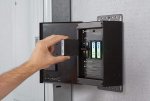mikeames
Senior Member
- Location
- Germantown MD
- Occupation
- Teacher - Master Electrician - 2017 NEC
Maybe this has been out for a while but I just came across it and like the replaceable modules. I always had issue with the fact the SPD had to be replaced due to the sacrificial nature, but I still installed them in my house. Now this. I am thinking of getting this for my own house. Anybody have experience with this one? My only concern is the length of the conductors to feed this impact performance, or is that minimal. I thought the length of the conductors need to be as short as possible.
Also, I heard the term TVSS is no longer used, or replaced, why?

Also, I heard the term TVSS is no longer used, or replaced, why?

Last edited:

